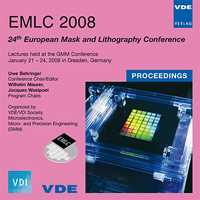Introduction of new database reflected tritone algorithm for application in mask production
Konferenz: EMLC 2008 - 24th European Mask and Lithography Conference
21.01.2008 - 24.01.2008 in Dresden, Germany
Tagungsband: EMLC 2008
Seiten: 8Sprache: EnglischTyp: PDF
Persönliche VDE-Mitglieder erhalten auf diesen Artikel 10% Rabatt
Autoren:
Schulmeyer, Thomas; Heumann, Jan (Advanced Mask Technology Center Inc, Postfach 11 01 61, 01330 Dresden, Germany)
Schmalfuss, Heiko; Lang, Michael (KLA-Tencor GmbH, Moritzburger Weg 67, 01109 Dresden, Germany)
Inhalt:
At Photomask Japan 2007 the new algorithm of Fast Integrated die-to-die T+R (DDTR) for the views of P90 and P72 for the KLA Tencor TeraScanHR mask inspection system was presented. At the same time a new algorithm for P72 in database tritone mode for reflected light (DBRt) was introduced. Both modes can be used together as one combined inspection to detect pattern and contamination defects on production masks. It was shown that these new algorithms allow for creation of a new inspection strategy with improved throughput and a reduced amount of inspections. Currently an inspection strategy has to cover at first a pattern inspection (normally a combination of die-to-die and additional database inspections) for finding hard defects on a mask and then as second step a contamination inspection (STARlight2TM). The hard defects have to be repaired and the contaminations can be cleaned. The new inspection strategy allows for detection of all critical hard and contamination defects on a mask with one single combined inspection, enhancing productivity. At BACUS 2007 the first evaluation of this new kind of inspection strategy for manufacturing of masks was described for two production plates of different design. At that time only the database reflected tritone algorithm for the view of P72 was available. The changes in inspection strategy could only go together with a change of view from P90 to P72. With view P72 higher overall sensitivity could be reached and smaller secondary features could be inspected. However, these improvements may not be necessary for all plates and may need more time than a comparable P90 inspection. Today the standard contamination inspection for critical masks is the P90 STARlight2TM (SL2). To do a time effective parallel combo inspection with DDTR and DBRt the same view has to be used. An extension of the database reflected tritone algorithm to the P90 view is now available. This gives the mask manufacturer the flexibility to change the inspection strategy for P90 and P72 dependent only on feature size on mask or minimal allowed defect size. The results of the evaluation and the comparison of this P90 database reflected tritone algorithm with the P90 STARlight2TM and P90 Fast Integrated die-to-die T+R will be presented in this paper. It will be shown that comparable results can be expected for P90 DBRt and P90 DDTR versus P90 STARlight2TM without missing any critical defects.


